The Toyota GR Yaris is a thrilling rally car for the road

Say “homologation special” to Joe Public and he’ll probably give you a blank look. For car geeks, though, those words are like yelling “Walkies!” to a dog. Our ears and eyebrows prick up. We may even start salivating. Because these are some of the most exciting cars ever made.
In a nutshell, homologation specials are road cars built to fulfill the requirements of a race series. The original BMW M3 of the mid-1980s is a textbook example. In order to compete in Group A Touring Cars and the German DTM championship, BMW had to build 5,000 street-legal versions of its racer. The result was the E30 M3 – a factory-modified 3 Series with competition kudos. It’s still considered a dynamic benchmark today.
The GR Yaris, then, exists because of the World Rally Championship – and Toyota must build 25,000 examples of its homologation hot hatchback (try saying that in a hurry) to take part. For the world’s biggest car brand, that’s a drop in the East China Sea, but this car wasn’t conceived to make money. Its raison d’être is to win rallies.
A rally car in reverse
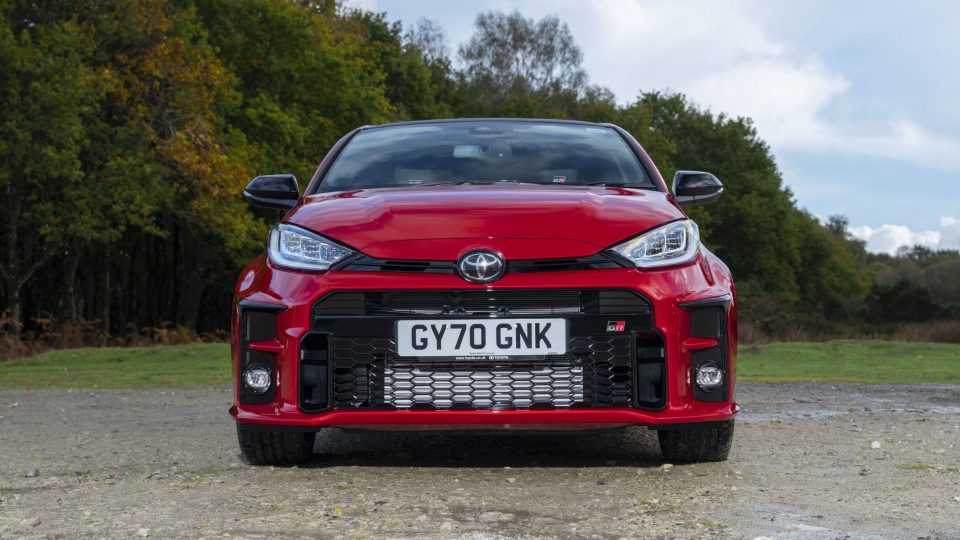
To that end, the GR Yaris has been ‘reverse engineered’. Toyota president – and fully paid-up petrolhead – Akio Toyoda explains: “In the past, we tried to be successful by taking a production car and adapting it for motorsport. The GR Yaris is the first model to reverse that process. We use a vehicle made to win in motorsports and turn it into a production car.”
In other words, this isn’t really a Yaris at all. It’s a thinly disguised WRC weapon; a Parkour athlete in weekend leisurewear. The obvious giveaway is the three-door body; the shopping-spec Yaris is five-door only. The roof is also 95mm lower to help the rear spoiler generate more downforce (and gives the GR a sleeker, more coupe-like profile). You can’t miss the beefier bumpers, swollen wheelarches and 18-inch alloys either.
Homologation rules stipulate that a rally car’s body panels must be made from the same materials as the showroom version. So, thinking backwards, Toyota engineers fitted their WRC contender with an aluminium bonnet, tailgate and doors (saving 24kg), plus a forged carbon fibre roof (another 3.5kg) – and the road car followed suit. Kerb weight for the four-wheel-drive Yaris is 1,280kg, just 18kg heavier than the front-driven Ford Fiesta ST.
Small but mighty
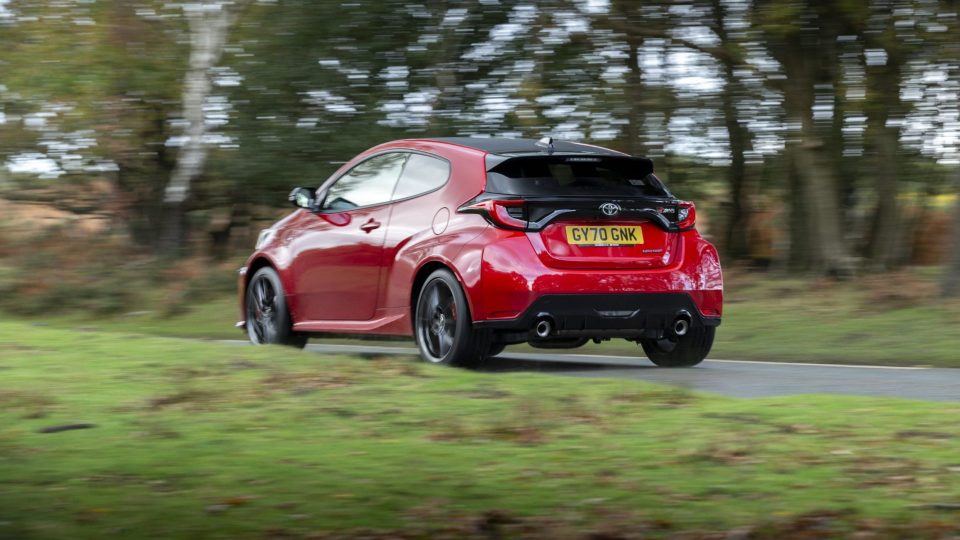
Beneath that stubby bonnet is a three-cylinder engine. No wait, come back! This is the most powerful three-pot motor in the world and, according to Toyota, the smallest and lightest 1.6-litre turbo. Hardware imported directly from motorsport includes a ball bearing turbocharger and multi-jet oil piston cooling. Maximum power is 261hp at 6,500rpm, with 266lb ft of torque from 3,000rpm.
Driving all four wheels via a six-speed manual gearbox, that means 0-62mph in 5.5 seconds and a limited top speed of 143mph. The GR-Four system divides torque between the front and rear axles, depending on the drive mode selected. In Normal, the split is 60 percent front, 30 percent rear; in Sport that switches to 30/70, while Track offers an even 50/50. Incidentally, Toyota says Track mode is also best for snow or gravel.
Opting for the Circuit Pack – as fitted to our test cars – adds a Torsen mechanical limited-slip differential to each axle, so drive can be directed left or right between individual wheels. Toyota WRC driver Jari Matti Latvala says this makes the Yaris “more agile” and “definitely faster”. Good.
Circuit breaker
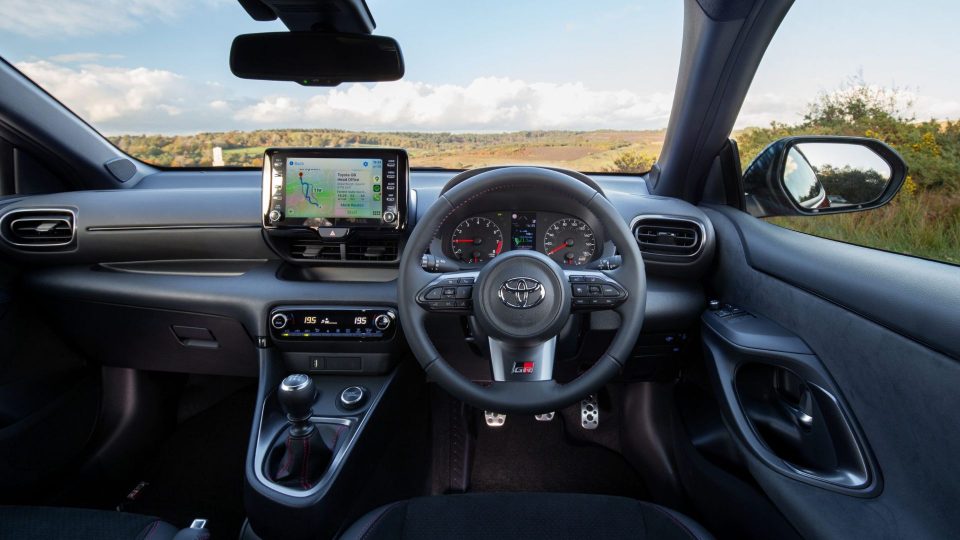
The GR Yaris is one of three GR (Gazoo Racing) models to be sold in Europe, joining the GR Supra and forthcoming new GT86. Prices start from £29,995, or £269 a month on PCP finance, and standard equipment includes 18-inch cast alloy wheels, climate control air-con and touchscreen infotainment with Apple CarPlay and Android Auto. Only four paint colours are available: no-cost white, or optional pearl white, red and black.
Upgrading to the Convenience Pack (£32,175 or £289 a month) adds a JBL audio system, sat nav, parking sensors, head-up display, blind-spot monitor, rear cross-traffic alert and ambient cabin lighting.
The Circuit Pack is the one you want, though. For £33,495 or £299 a month, it features the Torsen diffs, stiffer suspension, 18-inch forged BBS alloys, sticky Michelin Pilot 4S tyres and red brake calipers. Go hard or go home, as they (probably) say in rallying.
Ready for Sussex Rally GB
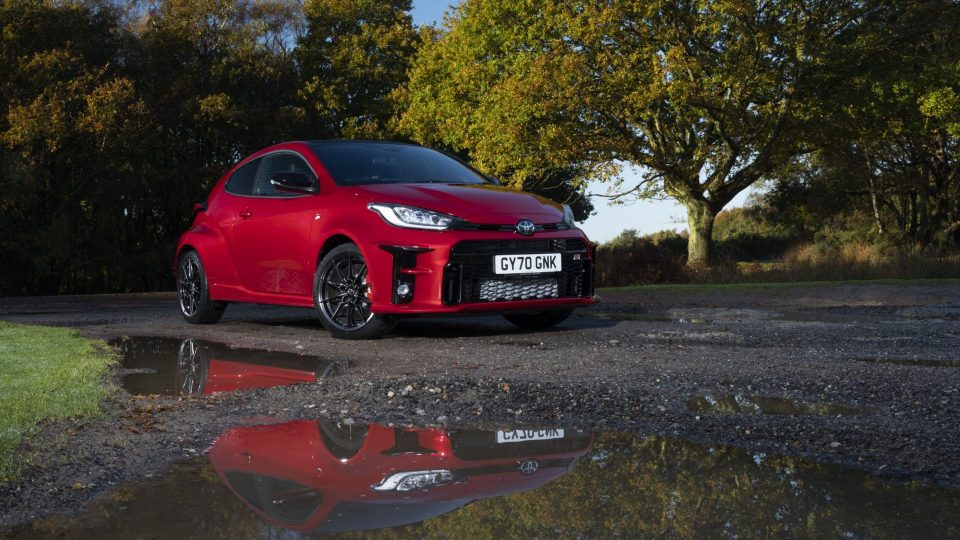
I collect the GR Yaris key and study the map for what Toyota’s press team jokingly calls ‘Sussex Rally GB’. Starting from the press workshop in Crawley, the route heads south towards Devil’s Dyke, writhing around on capillary lanes like a doodle on a sketchpad. If anywhere can make this halo car shine bright, it’s here.
Squat and square jawed, the GR resembles a Yaris after six months of boot camp, its cartoonish bulges magnified by the stark winter sun. The huge 356mm front brake discs are larger than those fitted to the Supra, and scarcely seem to fit inside the spidery black wheels. The whole car looks shrink-wrapped and ruthlessly fit for purpose.
Open the door and, sadly, there’s no race car scaffolding or a giant sequential gear shifter. Indeed, the dashboard is near-identical to the standard car, save for a GR-Four system indicator and turbo pressure monitor within the media system. There’s also a small plaque between the seats that says ‘Developed for the FIA World Rally Championship’. You won’t see that on Auntie Joan’s Yaris.
The 50-metre test
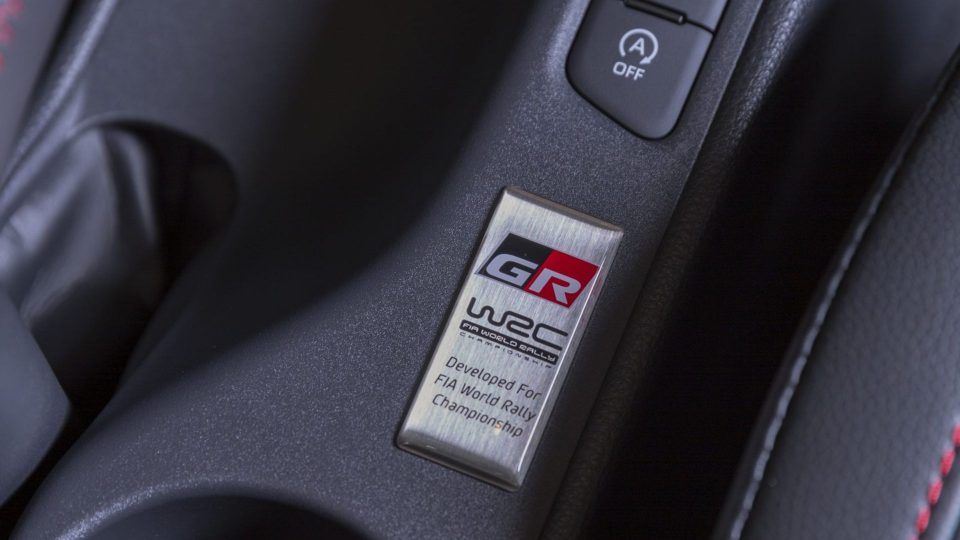
The seats feel like a gentle bear-hug, with big bolsters that wedge you in place. I’d prefer to sit a bit lower – a common complaint with hot hatches – but the driving position is otherwise very adjustable. Toyota has paid attention to the important touch-points, too. The leather wrapped steering wheel is lovely to hold, while the alloy pedals are enlarged to aid heel-and-toe downshifts.
Exiting the workshop, the GR passes the 50-metre test. Its steering feels alert, its gearshift knuckly and mechanical, its damping tightly wound. There’s a sense of carefully calibrated control weights that Porsche, for example, does so well. You just know that serious men in Gazoo Racing fleeces spent hours on this stuff. I trundle through one of the sprawling industrial estates that surround Gatwick, then filter onto a dual carriageway. Mirror, signal… BWAAAAARP!
The red needle passes 3,500rpm and the Yaris erupts like a lit firework. The turbocharged triple feels slightly flat lower down, but relishes being revved. Peak power comes at 6,500rpm, by which point you’re hurriedly slotting the next gear. It sounds feisty, too – more intake than exhaust, its guttural snarl not unlike a Subaru flat-four. Mercifully, there are no artificial pop-pops, although I do discover later that the noise is ‘enhanced’ via the stereo speakers.
Fast and furious
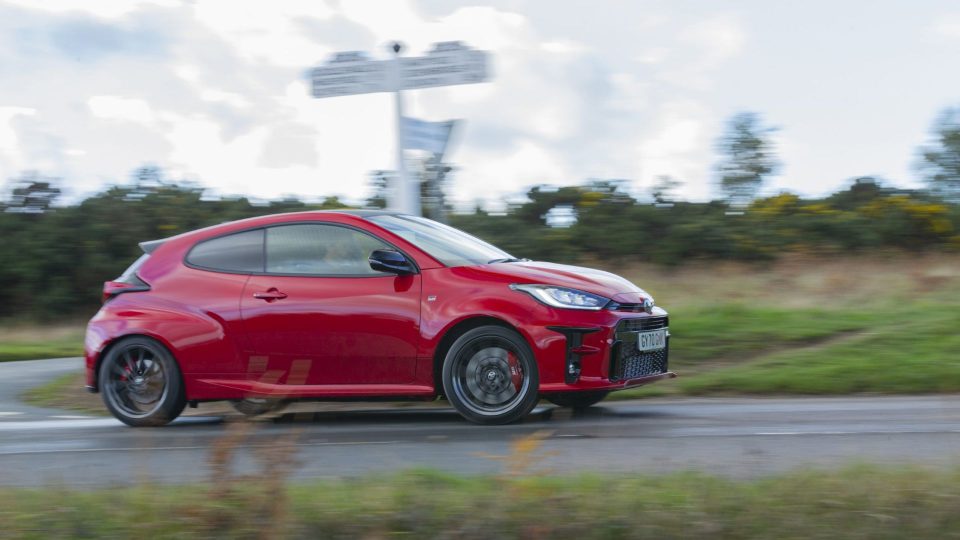
The Toyota’s isn’t as wired and effervescent as a Fiesta ST, but it carries speed through corners like a Scalextric. Blasting across a series of roundabouts, I scarcely need to slow down. Turn-in is tenacious, followed by neutral grip and slingshot traction. Chief engineer Saito-san says he prefers the car in Track mode and I quickly reach the same conclusion. Normal is, well, too normal, with the front-driven feel of a regular hot hatch. There’s added playfulness in rear-biased Sport, but this car is all about point-to-point pace. And that means all four wheels doing equal work.
Now I’m on the kind of roads where the GR Yaris can sharpen its claws: narrow, switchback lanes that are dusted with mud, gravel and loose leaves. And it seems right at home. The zingy engine feels unburstable, diffs biting hard as the car hunkers down over crests and compressions. The experience is intense but confidence-inspiring, helped by the fact that – despite its extra girth – I’m still driving a small car. Where a new Porsche 911 would have to slow down, the Yaris hardly pauses for breath.
What’s most surprising is the ride quality. This is the Circuit Pack car, remember, yet it offers a loose-limbed pliancy that’s tailor made for British tarmac. Too often, highly strung hot hatches are jittery and easily deflected on roads like these (here’s looking at you, Mini GP), but the Toyota’s rally roots shine through in its athletic body control. It shrugs off potholes, mixed surfaces and adverse cambers like Jari Matti at maximum attack.
There is one rally-inspired feature that I didn’t test. Mindful of how WRC drivers take tight corners, the GR Yaris has a manual handbrake that decouples the GR-Four 4WD system when you pull it. Not that useful on the B2135, but great fun in an empty car park…
A homologation hero
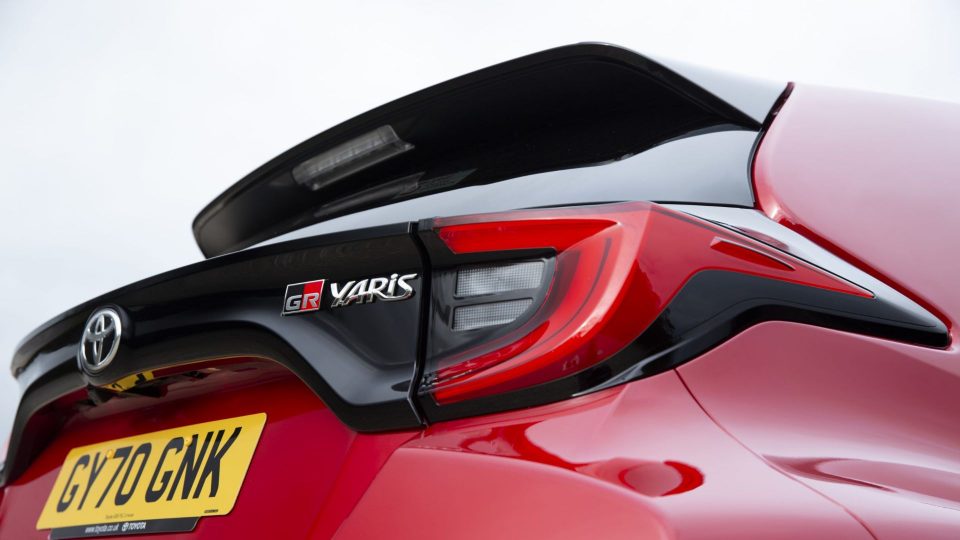
As with many areas of life, 2020 has thrown a giant spanner at the GR Yaris. The Covid pandemic has delayed rallying rule-changes, meaning its WRC cousin can’t race next season. If hybrid tech is introduced for 2022, as rumours suggest, it may never race at all.
Does that make this homologation special less, er, special? Not really. As a teenager playing Gran Turismo in the 1990s, my dream car was the Subaru Impreza 22B – another rarified rally refugee. The Toyota is cut from the same cloth. It feels exotic in a way a VW Golf R never will.
Still, most people will spend their £33k or so on the Volkswagen. And that’s fine. It’s more powerful, more practical and just as quick on a B-road. But arrive at a Cars and Coffee event in a Golf R and nobody will give you a second look. Turn up in a GR Yaris and you’ll be hailed a hero. Auntie Joan wouldn’t understand.
PRICE: £33,495 (Circuit Pack)
0-62MPH: 5.5sec
TOP SPEED: 143mph
CO2 G/KM: 186
MPG COMBINED: 34.3